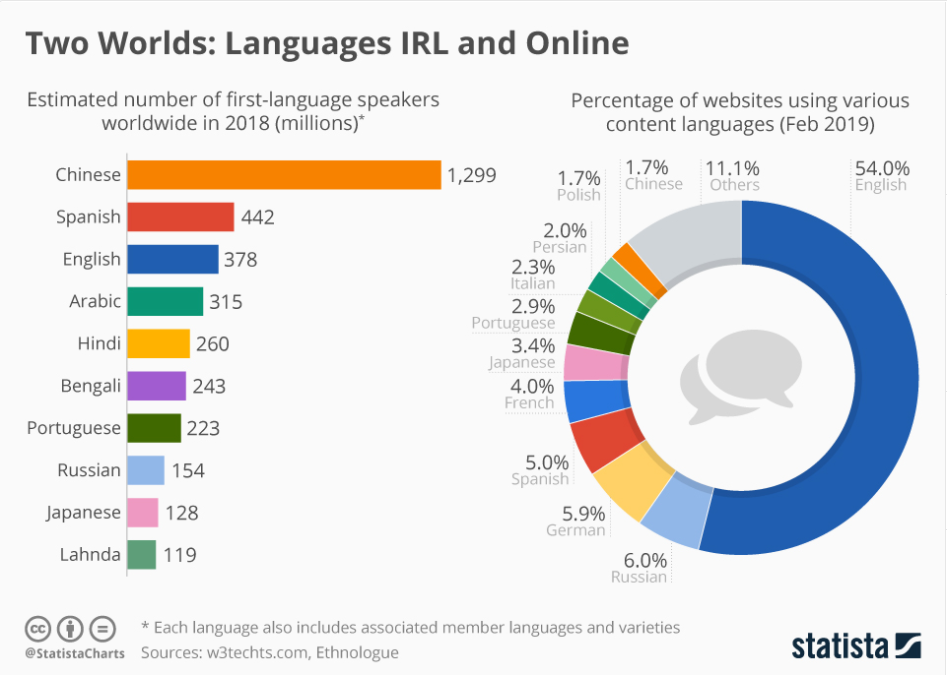Access to Information
- raymondtartaglia
- Feb 7, 2021
- 2 min read
This is my first blog post ever, so I wanted to make sure I found the right “thing” to read and reflect on. I have read several articles a day thanks to my Google Alert. Finally, I came across this article called Language Is Power: 5 Action Steps for Communicating in a Multilingual World. Right as I saw it in the Google Alert email I thought that it sounded relevant.
I was not disappointed. The author, Sharda Sekaran, starts off with some pretty interesting statistics about the advantages native English speakers have when it comes to accessing information. She says “of the top 10 million websites, 54 percent are in English” (Sekaran, 2021). This information was pulled from the following infographic presented by Niall McCarthy:

Now, as a mathematics person myself, I found the data to be interesting and extremely eye opening. I never gave this much thought before and especially not from the perspective of a non-native English speaker, like plenty of my student are. I know that even some of my textbook resources for my classes are in English which makes it very hard to translate into a different language for my students.
Sekaran then goes on to discuss the connection between inability to access information due to language barriers and a lack of information about COVID-19. This is a very in-the-moment connection to make and it again makes me reflect on how easily we are able to access information because I am a native English speaker.
Finally, Sekaran, provides the promised 5 Action Steps that can be taken to “help dismantle language barriers”. Those steps are as follows:
1. Collect data on which languages people speak.
2. Use plain language.
3. Develop terminology and glossaries.
4. Include multimedia formats.
5. Work with trained translators.
Now, I’m sure these steps were thought of in terms of traditional communications, both written and verbal, as they relate to communicating important information with non-native English speakers. The connection can be made to communicating important information regarding COVID-19, for example. I think these steps are also important to regard as an educator myself. I can be cognitive on language when I am creating lessons for my students. I am going to make an active effort to convert the traditional mathematics jargon to more of a plain language in the hopes of building up to the inclusion of more technical mathematical vocabulary. I always try to provide definitions and multimedia support in all of my classes; that is something that helps all visual learners. Finally, I will work on appropriate translations for make sure my students are getting the exact information they need.
McCarthy, N., & Richter, F. (2019, February 21). Infographic: Two Worlds: Languages IRL and online. Retrieved February 07, 2021, from https://www.statista.com/chart/14900/two-worlds_-languages-irl-and-online/
Sekaran, S. (2021, February 03). Language is power: 5 action steps for communicating in a multilingual world. Retrieved February 07, 2021, from https://nonprofitquarterly.org/language-is-power-5-action-steps-for-communicating-in-a-multilingual-world/



Wow Ray - thank you so much for sharing such an eye-opening article! I had never really thought about this before, and the impact that would have on those who don't speak English themselves. The language barrier affects their ability to access information and content. I enjoyed that you shared the graphic from the article to help me visualize and fully understand the extent of the information provided. Also, thank you for including the 5 action steps to be taken in order to help dismantle language barriers. This is something I will take into consideration when planning my lessons to ensure I am meeting the needs and providing access to all of my students, including ELLs.
What a well-written first blog post! The five action steps really chunk the necessary steps in being sure that we are eliminating language barriers and supporting our English language learners. Your personal anecdotes within this post also add to the overall impact it has. I enjoyed taking a look at the infographic as well, as I'm a visual learner and soak in more information by actually seeing it. Great p
ost!